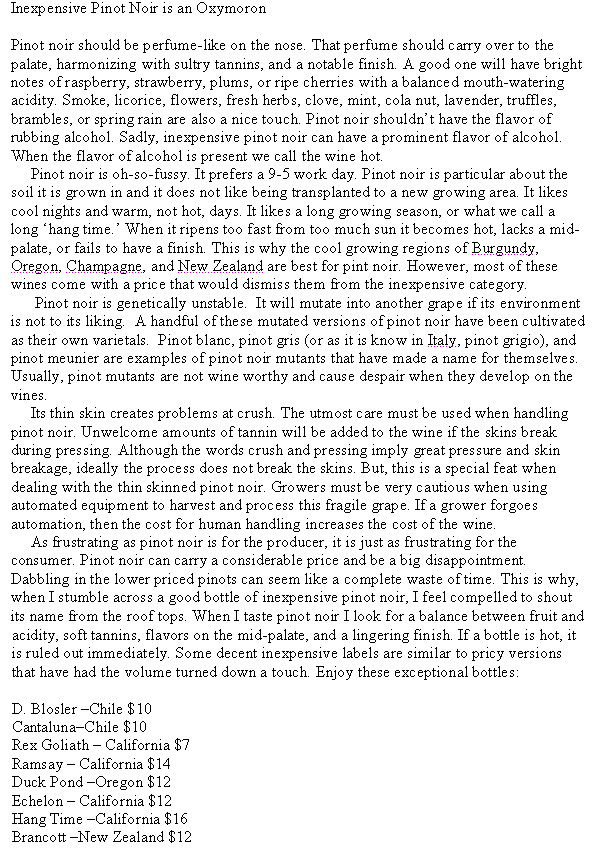




Articles are property of Brenda Francis and are not to be reproduced in any way without written consent from Brenda Francis. Inexpensive Pinot Noir is an Oxymoron Pinot noir should be perfume-like on the nose. That perfume should carry over to the palate, harmonizing with sultry tannins, and a notable finish. A good one will have bright notes of raspberry, strawberry, plums, or ripe cherries with a balanced mouth-watering acidity. Smoke, licorice, flowers, fresh herbs, clove, mint, cola nut, lavender, truffles, brambles, or spring rain are also a nice touch. Pinot noir shouldn't have the flavor of rubbing alcohol. Sadly, inexpensive pinot noir can have a prominent flavor of alcohol. When the flavor of alcohol is present we call the wine hot. Pinot noir is oh-so-fussy. It prefers a 9-5 work day. Pinot noir is particular about the soil it is grown in and it does not like being transplanted to a new growing area. It likes cool nights and warm, not hot, days. It likes a long growing season, or what we call a long 'hang time.' When it ripens too fast from too much sun it becomes hot, lacks a mid-palate, or fails to have a finish. This is why the cool growing regions of Burgundy, Oregon, Champagne, and New Zealand are best for pint noir. However, most of these wines come with a price that would dismiss them from the inexpensive category. Pinot noir is genetically unstable. It will mutate into another grape if its environment is not to its liking. A handful of these mutated versions of pinot noir have been cultivated as their own varietals. Pinot blanc, pinot gris (or as it is know in Italy, pinot grigio), and pinot meunier are examples of pinot noir mutants that have made a name for themselves. Usually, pinot mutants are not wine worthy and cause despair when they develop on the vines. Its thin skin creates problems at crush. The utmost care must be used when handling pinot noir. Unwelcome amounts of tannin will be added to the wine if the skins break during pressing. Although the words crush and pressing imply great pressure and skin breakage, ideally the process does not break the skins. But, this is a special feat when dealing with the thin skinned pinot noir. Growers must be very cautious when using automated equipment to harvest and process this fragile grape. If a grower forgoes automation, then the cost for human handling increases the cost of the wine. As frustrating as pinot noir is for the producer, it is just as frustrating for the consumer. Pinot noir can carry a considerable price and be a big disappointment. Dabbling in the lower priced pinots can seem like a complete waste of time. This is why, when I stumble across a good bottle of inexpensive pinot noir, I feel compelled to shout its name from the roof tops. When I taste pinot noir I look for a balance between fruit and acidity, soft tannins, flavors on the mid-palate, and a lingering finish. If a bottle is hot, it is ruled out immediately. Some decent inexpensive labels are similar to pricy versions that have had the volume turned down a touch. Enjoy these exceptional bottles: D. Blosler -Chile $10 Cantaluna-Chile $10 Rex Goliath - California $7 Ramsay - California $14 Duck Pond -Oregon $12 Echelon - California $12 Hang Time -California $16 Brancott -New Zealand $12